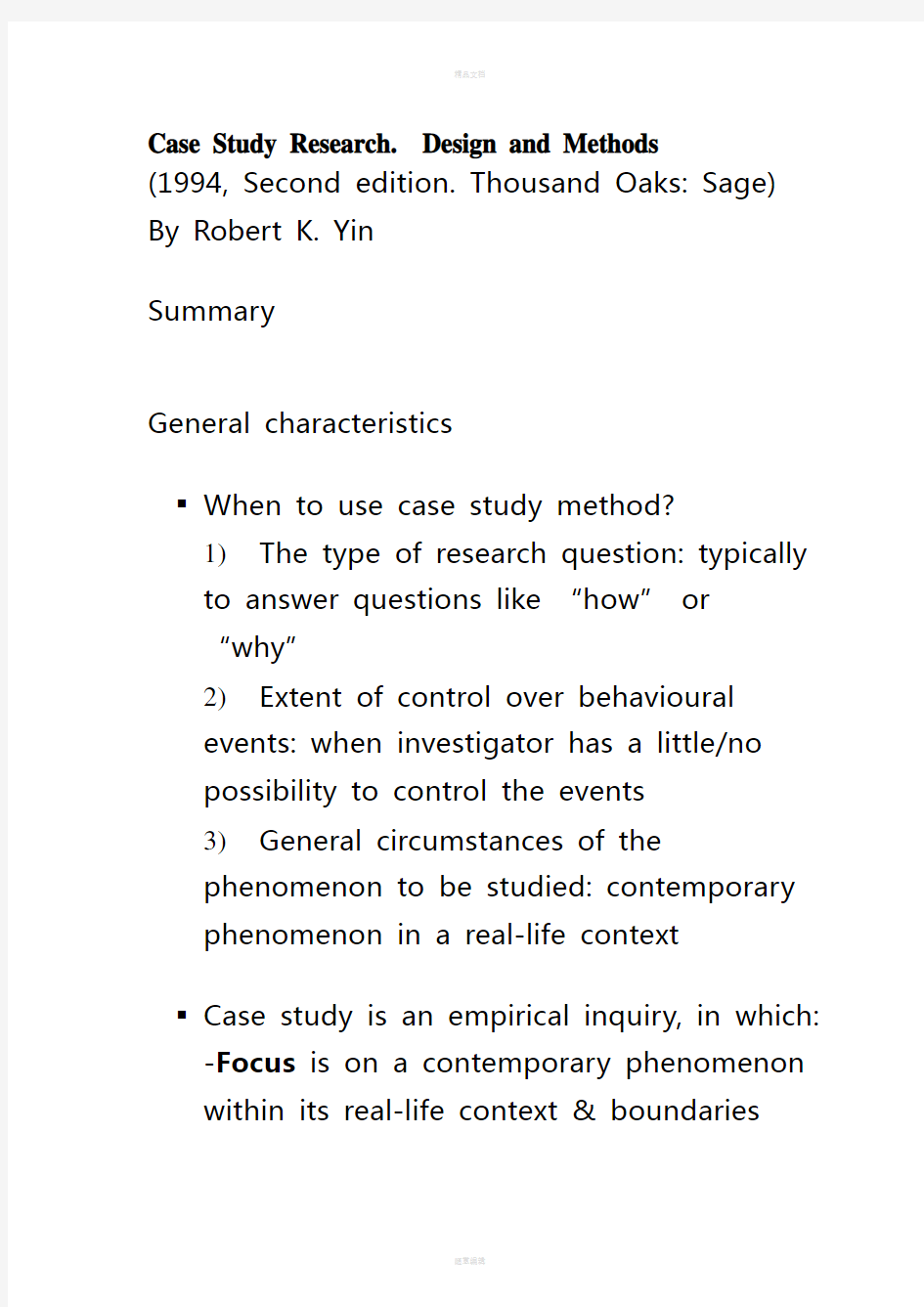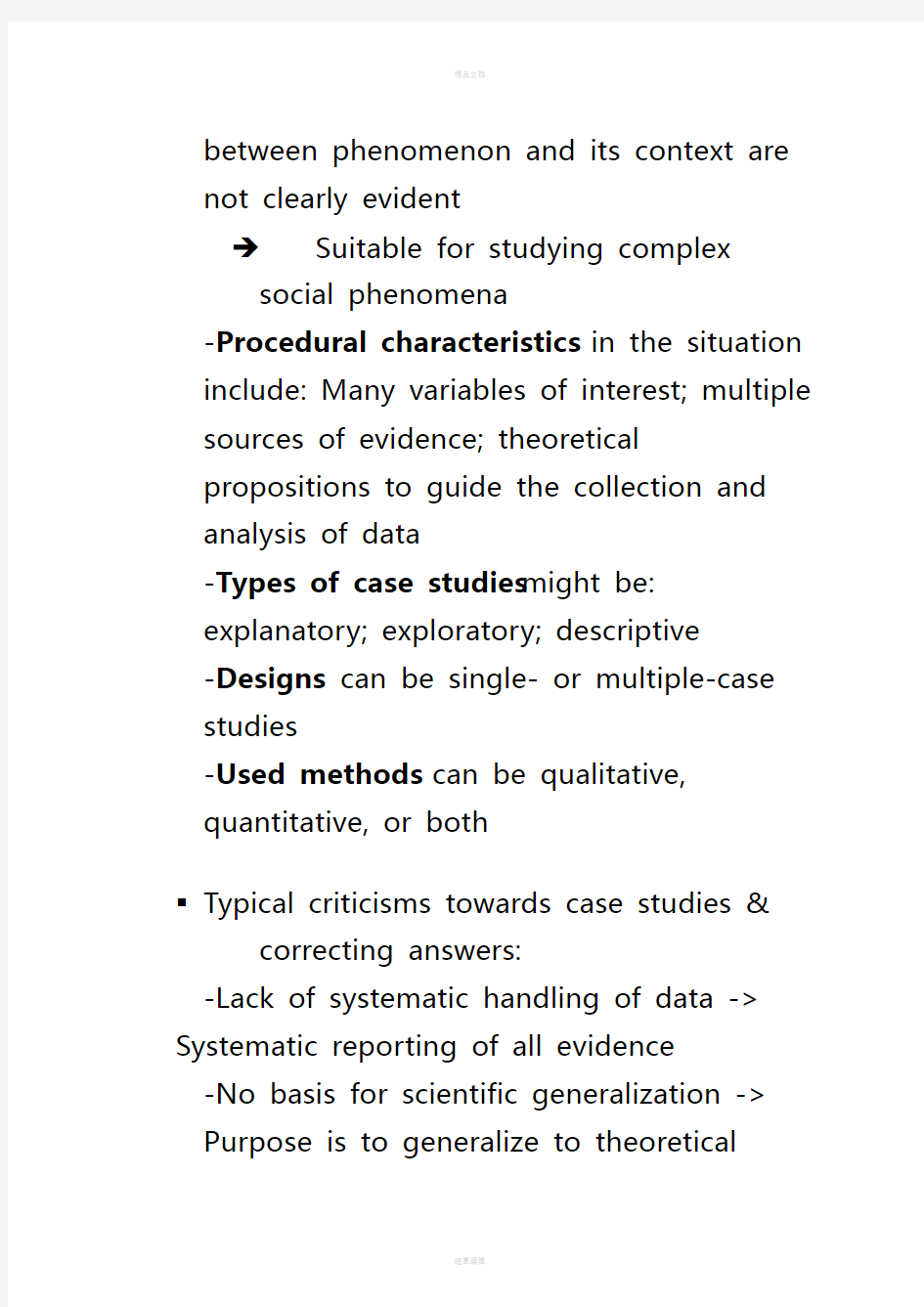个案研究:方法和设计


Case Study Research. Design and Methods (1994, Second edition. Thousand Oaks: Sage) By Robert K. Yin
Summary
General characteristics
?When to use case study method?
1)The type of research question: typically
to answer questions like “how” or
“why”
2)Extent of control over behavioural
events: when investigator has a little/no
possibility to control the events
3)General circumstances of the
phenomenon to be studied: contemporary phenomenon in a real-life context
?Case study is an empirical inquiry, in which:
-Focus is on a contemporary phenomenon within its real-life context & boundaries
between phenomenon and its context are not clearly evident
→Suitable for studying complex
social phenomena
-Procedural characteristics in the situation include: Many variables of interest; multiple sources of evidence; theoretical propositions to guide the collection and analysis of data
-Types of case studies might be: explanatory; exploratory; descriptive
-Designs can be single- or multiple-case studies
-Used methods can be qualitative, quantitative, or both
?Typical criticisms towards case studies & correcting answers:
-Lack of systematic handling of data -> Systematic reporting of all evidence
-No basis for scientific generalization -> Purpose is to generalize to theoretical
propositions, not to population as in
statistical research
-Take too long, end up with unreadable
documents -> Time limits & writing
formula depend on the choices of
investigators
Case study research design
?Central components of a case study design & their functions:
1) A study’s questions –“how”,
“why”
2)Study’s (theoretical) propositions –
pointing attention, limiting scope,
suggesting possible links between
phenomena
3)Study’s units of analysis – main units
must be at the same level as the study
questions & typically comparable to
those previously studied
4)Logic linking the data to the
propositions – matching pieces of
information to rival patterns that can
be derived from the propositions
5)Criteria for interpreting the findings –
iteration between propositions and
data, matching sufficiently contrasting
rival patterns to data; there is no
precise way of setting the criteria Research design links the data to be collected and conclusions to be drawn to the initial questions of the study – it provides a conceptual framework & an action plan for getting from questions to set of conclusions.
?Preliminary theory & blueprint of the
study: having solved the five steps
mentioned above leads to the formation of
a loose theory & a blueprint related to the
topic of study
-Initial theory& understanding of what is being studied is necessary before any
field contacts; the complete research design embodies a “theory” of what is being studied
?Deciding between explanatory,
exploratory and descriptive designs: -Depends on the richness of the rival propositions in theories related to the topic of the study; richest theories allow explanatory designs
-> Search for theoretical propositions that can be elaborated to cover study questions, propositions, units of analysis, data-proposition links & criteria of interpretation -> Reviewing literature, discussing with investigators, asking challenging questions, thinking what is to be learned from the study
-> Being aware of the range of theories & selecting the required level (individual, organization, societal)
-> Construction of the design / conceptual framework takes time & can be difficult, but is a crucial step for the success of the study
?Selection of the cases:
-Cases should be selected in the same way as the topic of an experiment is selected -> Developed preliminary theory is used as a template with which to compare the characteristics & empirical findings from the case(s)
-> Selected cases should reflect characteristics & problems identified in the underlying theoretical propositions / conceptual framework
?The level of generalization of the study results = appropriately developed preliminary theory / study design
-Mode of generalization = theory-related analytic generalization, not statistical
